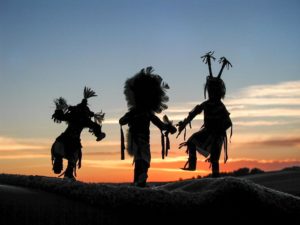Amongst celebrations such as Christmas and Hannukah, December also brings in the Winter Solstice, or in other words, the shortest day. The shortest day is an event that is celebrated across the world by many different cultures, as it can have a strong spiritual symbolism for many different traditions. One remarkable Winter Solstice celebration, is the Soyal celebration, held every year by the Hopi peoples. The Soyal ceremony is one of the most important ceremonies of the year, bringing together family and friends in the community, and representing hope for the future.
Taking place on the 22nd of December, The Soyal ceremony occurs as many hope to bring back the Sun after its long slumber over Winter. As inhabitants of northern Arizona, the Hopi people have been celebrating the awakening of the Sun for thousands of years. The tradition behind the special ceremony marks the date when the Kachinas came down from their home in the San Francisco Peaks to bring the Sun back to the world. The Kachina’s are the spirits who guard over the Hopi and Zuni people, and dance at the Winter Solstice Soyal Ceremony. Whilst doing so the spirits sing the Soyaluna (or Soyalangwul), understood to mean ‘Establishing Life Anew for All the World’. This signifies that the Kachinas are sending messages and prayers of rain, bountiful harvests, and healthy life in the new year. They also arrive plentiful with gifts and food, whilst teaching important lessons of good behaviour. The Kachina, of which there are over two hundred and fifty types, represent various beings, from animals, nature, and clouds.

Consequently, there is a true sense of rejuvenation and hope for the new year, further symbolised by the fact that for the Hopi people, the shortest day symbolises the second phase of the Creation of Dawn of Life. The prayers and rituals completed on the day implement a plan of life for the coming year, and ceremonially turn back the sun towards its summer path. In some cases, the exciting celebration can last up to 16 days in the run-up to the 22nd of December, and similar to the rituals of Christmas, it is believed that the Kachinas bring gifts to the children. Furthermore, tradition is such a huge part of the ceremony, as family elders pass down stories to the children.
The Soyal ceremony is perhaps of greatest importance because it is understood by the Hopi people that everything that will occur in the following year is arranged and established at Soyal. This places the Winter Solstice celebration of the greatest importance, as it is a vital part of Hopi and Zuni ritual. Perhaps the shining positive mindset of the Hopi people can be replicated in your Winter Solistice celebrations this year?







